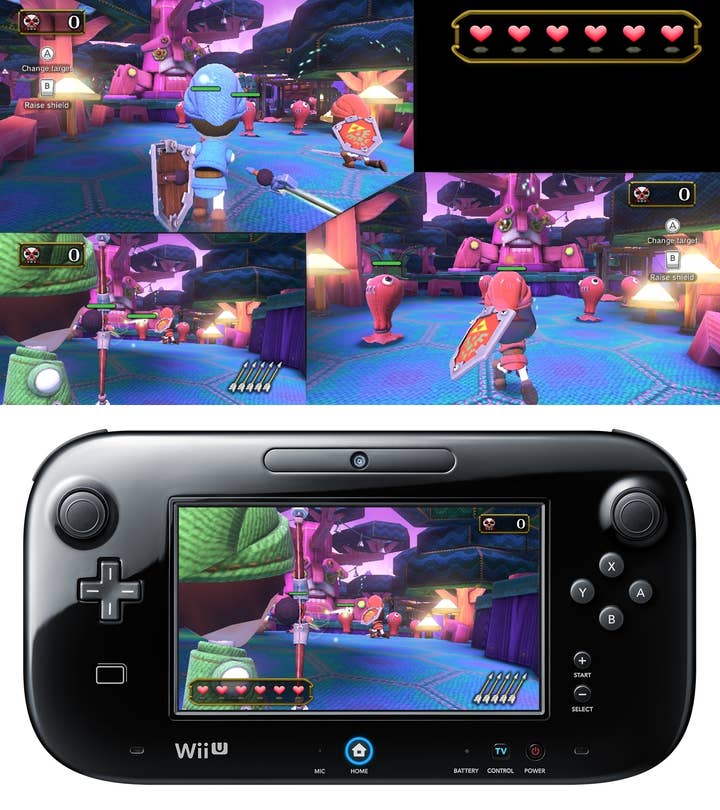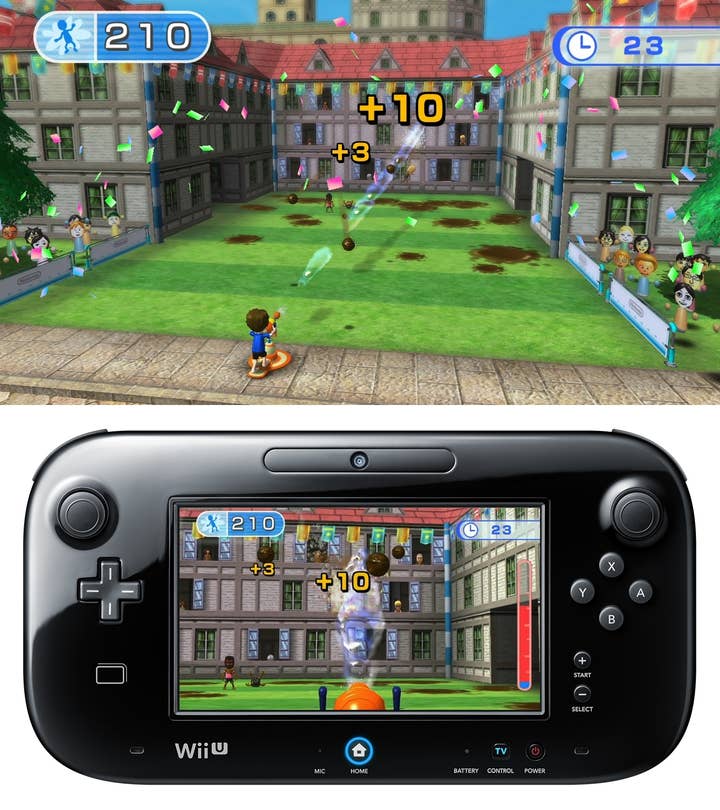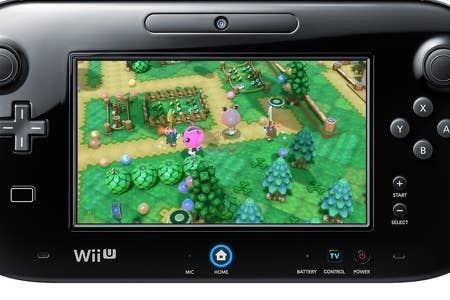Tech Focus: Second Screen Gaming
Digital Foundry takes a look at SmartGlass, the Wii U GamePad and the PS3/Vita connection.
Eight years after the release of the Nintendo DS, it seems that all three major platform holders now believe that dual-screen gaming is an integral part of the future of console gaming. At E3 this year, we saw the launch line-up for the new twin-screen Wii U, an announcement for smartphone/tablet support from Microsoft in the form of the SmartGlass initiative, while Sony offered up some interesting new integration ideas for PlayStation 3 and the PS Vita handheld.
The move towards dual-screen functionality is most likely prompted by a number of factors. Firstly there's a growing belief that gaming is moving away from the living room TV and towards discrete screens per player. It's an idea fuelled by the amount of time that people are spending using their mobile devices in the home, not just outside of it. Secondly, with the heavily rumoured Apple TV display just around the corner, we can almost certainly expect to see a greater level of convergence between the Cupertino giant's devices and there's a definite sense that the established forces in the games industry don't want to be caught off-guard in embracing the ideas this represents. Finally, for Sony at least, it represents a big opportunity to sell Vita to its mammoth PS3 installed base.
"The Wii U GamePad is the star of the second screen movement, but Microsoft SmartGlass and the PS3/Vita hook-up each have their own specific charms. It's all a question of take-up."
The very different approaches we see from Nintendo, Microsoft and Sony are intriguing. Each implementation appears to have its own relative strengths and weaknesses, but it's clear that in Wii U, Nintendo is very much in the driving seat. The advantages of its tech are numerous - the most strikingly obvious being that every single Wii U owner will possess the requisite technology out of the box, meaning that developers can concentrate their efforts on supporting the tablet knowing that it will reach every owner of the console.
There are also the fundamental strengths of the technology itself. There's a latency free connection between the tablet controller and the console, so game control is as fast and fluid as a conventional joypad (something you can't say for Apple's AirPlay) and the ability to mirror HDTV gameplay onto the tablet screen is an excellent ace-in-the-hole. For the first time, console gaming needn't encroach on regular TV viewing - the action can be switched between the main screen and the tablet simply and quickly.
Nintendo describe the tablet video feed as being latency free - something we were dying to try out. At a recent press event in London, we had the ability to film both tablet and screen simultaneously, and found that with mirrored content, the tablet actually received a fresh image up to seven frames - or 116ms - earlier than the LG HDTVs to which the Wii U was connected. This may suggest that the main displays were hopelessly laggy of course, and we need to factor in that the dev Wii U hardware was tethered to the unit (the suggestion being that AV data may have been beamed across from it) but even in a simple wired HDMI vs. tether contest, the results are still highly revealing about how seriously Nintendo is taking latency. WHDI technology operates with 1ms lag, and if Nintendo has opted for this solution, there should be no problem at all in this regard.
While Nintendo Land may not be quite the killer app the firm hoped it would be, it does show off a number of great concepts for dual-screen gameplay - specifically when it comes to multiplayer action. The Zelda mini-game for example sees a three-way split-screen on the main HDTV while the fourth player gets his own discrete view on the tablet. The potential for new concepts here is clear enough and third party developers are also coming up with some nice ideas. Rayman Legends' implementation of touch mechanics and a rhythm action mini-game also highlights the benefits of the low latency display and couldn't really be done on competing platforms. Platinum Games' P-100 allows you to draw shapes on the touchscreen, shepherding your units into aeroplanes to fly across gaps or swords for taking on enemies in direct combat. There's also dross amongst the gems though. Ninja Gaiden 3: Razor's Edge, for example, simply uses the screen to display potential combo branches. As you'll be preoccupied with what's happening on the main screen at any point, the touchscreen functionality is pretty much a waste of time.
"Xbox 360 has no Bluetooth functionality, suggesting that SmartGlass would need to interface with the console over WiFi - this suggests some degree of latency that could limit some of its gaming potential."
It's a bit difficult to properly assess what Microsoft wants to achieve with SmartGlass - its own second-screen solution. There is some genuinely revelatory stuff here, not so much from a technological perspective but certainly in terms of the business decision behind it. The bottom line is that Microsoft is enabling Android and iOS products from competing manufacturers to be tightly integrated with the Xbox 360 both in terms of enriching media playback (which is arguably where its strengths lie) and also by offering SmartGlass app integration with 360 gaming. The demo it came up with at E3 involved Madden NFL plays being plotted on the touchscreen before being beamed to the game: hardly revolutionary, but functional enough. Other demos appeared to offer slick-looking menu-driven functionality.
Microsoft has the advantage of being able to rely on an enormous installed base of existing devices in order to generate some momentum for SmartGlass support, but developers will need to create standalone apps for the touchscreen devices: it's believed that these are coded in HTML5 in order to provide a common ground across all mobile devices. Potentially then, Xbox 360 games can gain access to a lot of input-related data: touchscreen motions, gyroscope data, even GPS. Hopefully there is some degree of control on what personal information may be lifted from your devices: Xbox Live (and indeed PSN) already phones home with an immense amount of information on how you interact with the console, but we would hope that the HTML5 protocol would limit access by default to stop this happening.
Conceivably then, SmartGlass development should be fairly stress-free but it is perhaps somewhat limited in comparison to the capabilities of the Wii U. Touchscreen apps couldn't offer anything like the richness we see with the GamePad, and even the notion of using the device as a controller could perhaps be limited. Xbox 360 has no Bluetooth receiver: therefore it cannot pair directly with the device - interactions will need to be carried out through WiFi, and here what we're not sure is if the connection is direct, or whether it will have to negotiate a router, potentially adding varying levels of lag.
At E3, SmartGlass was touted primarily as a means to explain what the hell is going on in Game of Thrones via the use of an interactive map of Westeros, and other streaming info related to what was happening during the show. It may well be the case that gaming applications will be rather more limited, and there'll almost certainly be no gameplay streaming or the pin-sharp response we see from the Wii U GamePad. Sony's second-screen offering does have some potential though.
"Sony's pursuit of CrossPlay titles and its excellent LittleBigPlanet 2 PS3/Vita upgrade offers an interesting, if somewhat resource-intensive, take on second screen gaming."
PlayStation has its own proprietary device that is eminently fit for purpose, if not quite as ubiquitous as SmartGlass devices, or as tightly integrated as the Wii U GamePad - but exciting new dual-screen gameplay concepts could surely give PlayStation Vita a shot in the arm. One of the most intriguing innovations we saw from Sony at E3 was a patch for LittleBigPlanet 2 that offered a colossal wealth of new dual-screen functionality - much of it a match for what we've seen from the Wii U playbook.
As Vita features full Bluetooth functionality, it has the potential to connect with the PlayStation 3 just as seamlessly - and with just as little latency - as the standard Dual Shock 3 controller. This in itself opens up some intriguing options: not only does Vita have face-buttons and twin analogue sticks, it can also relay gyroscope and touch data across to the main console - meaning new ways to interact with the PS3 version of the game.
The LittleBigPlanet 2 demo seen at E3 also showed us a wide range of potential applications for Vita as a second-screen. Asynchronous gameplay was revealed - we saw the Vita player immersed in a shooter, while the PS3 gamer was working his way through a maze situated inside the Vita gamer's ship: movements in the shooting game impacted the viewpoint as seen in the PS3 level. On top of that we also saw more traditional LBP gameplay with puzzles on the PS3 screen resolved through the loading of mini-levels on Vita. It's not exactly Nintendo Land, but with LBP2 being so adaptable, we wouldn't be surprised to see user-generated levels recreating the Wii U title's mini-games!


The Vita connection comes across rather like a mixture of the second-screen approaches seen in SmartGlass and Wii U: there should be the sharp level of response we see from the Nintendo console, but in common with SmartGlass we strongly suspect that a bespoke app would need to be loaded onto the Vita, necessitating development of standalone code that won't address a majority of users. New content would need to be streamed to the handheld (what we're seeing on Vita didn't look much like streaming video/Remote Play as we know it) and this seems to incur some delay. Regardless, it's an interesting evolution of what we've already seen from CrossPlay titles on Vita, where the same game is developed for both systems (MotorStorm RC amongst others) with some excellent use of multi-system gaming - WipEout HD being a great example.
"A big concern with SmartGlass is its status as something akin to a value-added extra. If it's not available to all Xbox 360 owners out of the box, why spend precious resources developing for it?"
Overall then: three dual-screen systems, three very different levels of implementation, each with their own unique strengths - and varying levels of developmental investment required.
Microsoft's SmartGlass approach has the benefit of actually finding a decent level of take-up owing to the vast amount of devices supported and the use of HTML5, but actual potential here is limited by the need to be compatible with so many devices, plus there are question marks over latency.
Sony's approach with Vita is already paying dividends, with the LBP2 demo showing plenty of potential, but the need to effectively generate two different versions of the game must surely sap developer resources significantly and for that reason, third party take-up must be questionable. On the plus side however, two autonomous pieces of code ensures that both PS3 and Vita can dedicate processing resources to their own players - something not even Wii U can provide.
Which leaves us with new Nintendo console, the star of the second screen movement. The principal difference here is that the tablet isn't just a value-added extra as it is with the Xbox 360 and PS3/Vita offerings - it's the core of the experience, with the most exciting, versatile technology. Hands-on with Wii U, we were drawn to the concepts Nintendo came up with and surprised by how robust the third party exclusives were. PS3/360 conversions with tablet functionality tagged on proved to be somewhat less compelling - and this is probably our principal worry with SmartGlass's gaming potential. If developers aren't going to make money with it (as they might from Vita double-dipping), and the applications are limited to value-added extras only, will SmartGlass attract the resources and ideas it needs to be successful?

